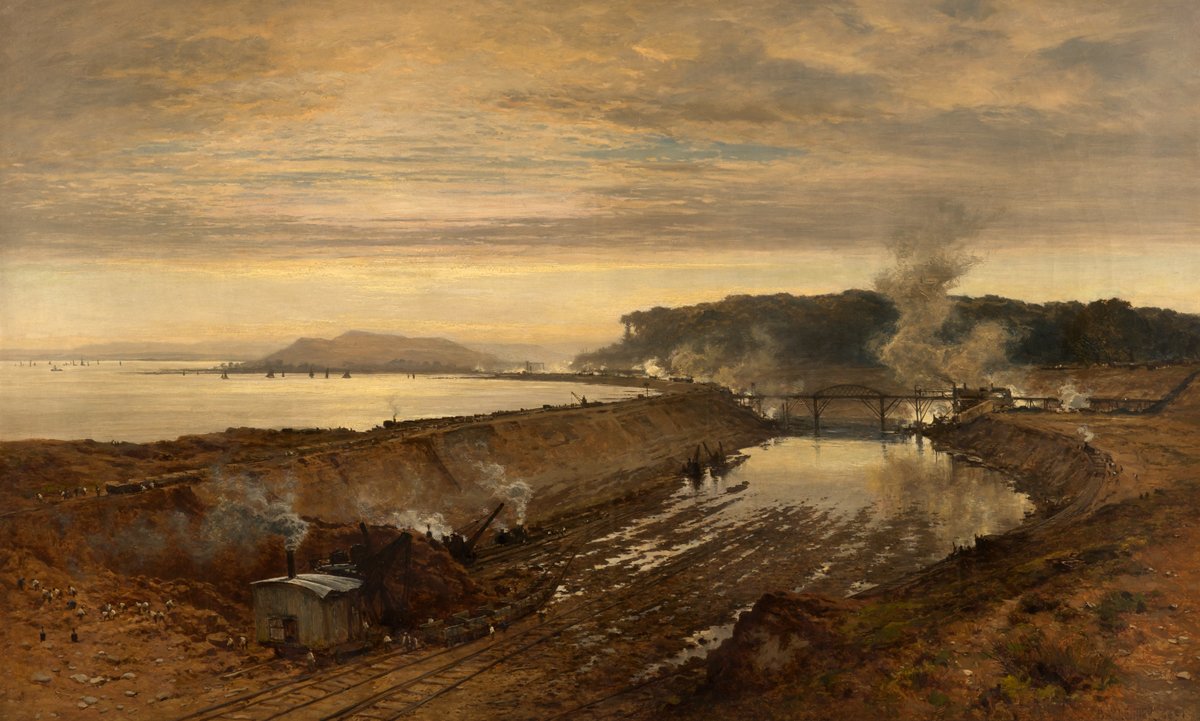2. The Big Ditch
16,000 Navvies and their Epic Excavation
How many people does it take to dig a 36-mile long ship canal? The answer – 16,000 Navvies (along with 6,000 wagons and 124 steam-powered cranes).

The Excavation of the Manchester Ship Canal - 1891. A painting by Benjamin Williams Leader, brother of the canal's engineer (from Gallery Oldham Collection).
Known as the digging of the ‘big ditch’, at its peak 16,000 Navvies dug the canal.
The work was undertaken using a combination of techniques including the use of some 200 steam cranes, along with pulseometer pumps and other machinery.
This mechanised work took place alongside excavation by hand, using picks, shovels, ropes and barrows.
It was hard, physical work with each Navvy paid the equivalent of £16 for a 10-hour shift. The canal itself cost £15 million (equivalent to over £1.6 billion today).
Photograph of Navvies at work showing a temporary railway track to allow the dug-up dirt to be carted away.
The Manchester Ship Canal Company employed a surgeon, Robert Jones, to treat the many men on site.
The engineering feat being undertaken was dangerous and injuries were commonplace. Over 3,000 men were seriously injured during the canal’s construction, and around 1,000 men lost their lives.
At the time, it was considered more dangerous to work as a Navvy than be in the British Army.
Portrait photograph of Robert Jones, the surgeon employed by the Manchester Ship Canal Company, during the excavation of the ‘Big Ditch’.
John Dobson, A Navvy’s Story
“I was born in 1876. I left Daresbury School at 13 and I went down the canal for a job. My job was nailing wagon bottoms in for the carpenters. There were thousands of men working on the canal. They drank heavily, they swore heavily and they lived rough. The salt of the earth. When they first let the water into the canal my house was flooded nearly up the the window sills. They let it in on a Saturday night. The cattle were standing up to their bellies in water. There’s no doubt that the making of the Ship Canal was the biggest operation carried out in this country and I am always pleased that I helped to make it.”
- Excerpts from the 1969 Port of Manchester Review for the 75th Anniversary of the opening of the Ship Canal.
Photograph: Thomas Walker, the project engineer, thought of the idea to build the temporary tracks to transport the soil from the site and also to carry workers to different sections.
“There’s no doubt that the making of the Ship Canal was the biggest operation carried out in this country and I am always pleased that I helped to make it.” - John Dobson, Navvy
Photograph: Back on land, the diving crew pose for a photograph with the suit hanging up to dry. In the latter stages of the construction, divers would frequently go underwater to check the depth of the waterway and ensure there had been no erosion.
Today you can visit the Navvies Community Garden at Salford Quays, near the MediaCity tram stop.
Created in 2022 by artist, Matthew Rosier working with local people, it stands in memory of the human endeavour, determination and sacrifice of the Navvies who made the Manchester Ship Canal dream a reality.
“It is estimated by the Navvies Union that up to 1,100 navvies died digging the Manchester Ship Canal. Such was the level of injury that field hospitals were pioneered here before being rolled out during the First World War. Living in squalid shanty towns and often paid in ale, these men were brutalised and shunned by the society they were building.”
- Artist Matthew Rosier
Photograph: The Navvies Community Garden at MediaCity created 135 years after excavation began. The earth in the flower bed represents the amount of earth dug by a single Navvy in a day.










